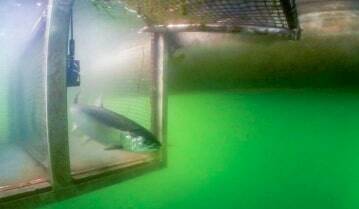Submitted by Wild Fish Recovery.
A new study evaluating alternative commercial fishing techniques further demonstrates the critical role commercial fish traps can play in recovering wild salmon and steelhead, improving fisheries management, and providing new sustainable fishing opportunities for coastal fishing communities. The publication confirms the ability of fish traps (or pound nets) to nearly eliminate unintended mortality of threatened salmon and steelhead encountered in commercial salmon fisheries of the Columbia River.
Researchers at Wild Fish Conservancy, alongside Dr. John Skalski of the University of Washington Columbia Basin Research Lab, published a new open-access paper in the international journal of Fisheries Research evaluating survival of wild adult salmon after being released from two commercial fish trap sites in the lower Columbia River. The results demonstrated post-release survival at or near 100% for spring and summer-run Chinook salmon and coho salmon released from passively operated fish traps between 2019 and 2021.
“The new publication provides the most clear-cut and irrefutable evidence to date that fish traps can nearly eliminate unintended mortality of threatened and endangered salmon and steelhead during harvest, allowing for sustainable and resilient commercial fisheries that can be enjoyed for generations to come,” says Emma Helverson, Executive Director of the Wild Fish Conservancy. “It is rare to find a win-win solution with such widespread benefits for wild fish, orcas, resource managers, and coastal fishing communities.”
In conventional fisheries, a major barrier impeding recovery is the accidental harvest and mortality of threatened and endangered populations by fishers targeting other wild or hatchery fish. Using ancient fish traps as a basic model, Wild Fish Conservancy biologists began evaluating contemporary fish traps in 2016 in efforts to develop a sustainable, alternative fishing practice to conventional gillnetting. The goal was to safely release wild salmon and steelhead in
need of recovery, while allowing fishers to selectively harvest those healthier, abundant runs, such as the Columbia River’s hatchery fish. Passively operated traps are engineered to allow fish to remain free-swimming at all times and to eliminate mortality effects commonly-associated with conventional fishing methods, including injury from nets, overcrowding, human-handling, and air exposure.
The new publication builds on and validates the results of previous studies evaluating passively operated fish traps on the Columbia River that have consistently shown survival near 100% for adult fall-run Chinook salmon, coho salmon, sockeye salmon, and summer-run steelhead released as bycatch. No other commercial fishing method studied on the Columbia River has demonstrated survival results as encouraging for wild salmon recovery and fish traps are the only gear to be rigorously evaluated through the scientific peer-review process.
The results of this new study also corroborate growing scientific consensus demonstrating that the most sustainable commercial salmon fisheries are those that occur in or near rivers where wild salmon return and use selective fishing techniques like fish traps that are proven to limit or eliminate harm to threatened and endangered bycatch.
“Our research team was completely blown away. When we analyzed the genetic and tag datasets for upriver populations of Chinook salmon heading to spawning grounds or hatcheries above Bonneville Dam, literally every adult Chinook passively captured and released from the fish trap survived the 167 km, 7-day journey to the dam,” said Wild Fish Conservancy biologist Adrian Tuohy. “The study was straightforward and the findings are irrefutable.”
In comparison to results for the fish trap, the commercial gillnet—the primary tool for harvest on the Columbia River—is known to cause ~49% mortality of threatened wild Chinook salmon encountered in the fishery. The lethal effects of the gillnet are also known to be severe for other fish species that become entangled as fishers target hatchery Chinook salmon, however, the true impact of the gillnet to these other threatened salmonid stocks in the Columbia River remains unknown as no post-release mortality data have been collected by state or federal management agencies.
“Few data, if any, have been collected for the gillnet and other alternative salmon fishing methods to understand post release mortality of bycatch…and hardly any of this work has undergone scientific peer-review,” says Tuohy. “Given the information that is available, it is clear that no other salmon fishing gear has come remotely close to achieving the peer-reviewed results we’ve seen for fish traps when it comes to releasing wild salmon unharmed and allowing for selective harvest of hatchery fish in Columbia River fisheries.”
Findings from this new publication are expected to help guide the Washington Department of Fish and Wildlife (WDFW) as the agency establishes rules for the alternative gear commercial fishery that will legalize fish traps at a localized scale on the lower Columbia River. In 2021, both the Governors of Washington and Oregon made policy and funding commitments to advance selective harvest practices like fish traps as alternatives to nontribal gill nets in the lower Columbia River. Washington state is currently implementing a voluntary gillnet license buyback program with the objective of redirecting those allocation impacts to alternative gears like fish traps or wild fish escapement.
Beyond the Columbia River, this research is also serving as an important working model to inspire other Pacific Northwest communities seeking sustainable harvest solutions. WFC is currently partnering with First Nations in British Columbia where the Canadian government has implemented unprecedented fishery closures in 2021 and 2022 out of conservation concerns.
“The situation facing the Columbia River is not unique. Throughout the Pacific Northwest coastal communities and resource managers are facing difficult decisions whether to close or further limit commercial fishing opportunities in order to protect our region’s most imperiled wild salmon,” says Helverson. “These new results could not have come at a better time and we are proud to play a role in advancing much-needed solutions that we hope will benefit
communities and recovery efforts coastwide.”



